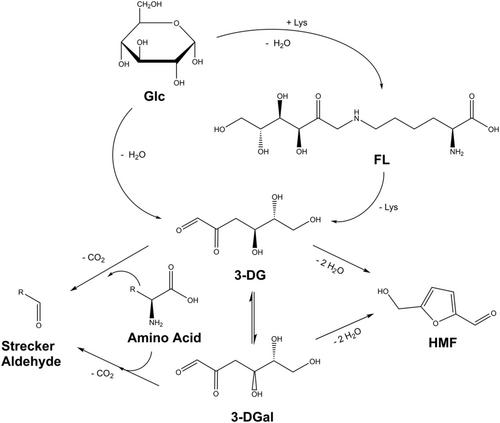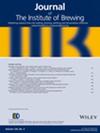下载PDF
{"title":"Formation and degradation of 3-deoxyglucosone as a key intermediate for ageing indicators during wort boiling","authors":"Arndt Nobis, Stefan Wendl, Thomas Becker, Martina Gastl","doi":"10.1002/jib.668","DOIUrl":null,"url":null,"abstract":"<p>The metabolite 3-deoxyglucosone (3-DG) is formed by carbohydrate caramelisation or the Maillard reaction. 3-DG is a precursor in the Strecker reaction forming beer ageing compounds, such as 2-methylbutanal or 3-methylbutanal. Although 3-DG is known as intermediate, recent studies have focused on 3-DG in beer. Foremost, the thermal load during wort boiling provides the best conditions for 3-DG formation and degradation, however, the reactivity of the dicarbonyl during the boiling process has not yet been explained. As a key intermediate, 3-deoxyglucosone could be a critical indicator for beer ageing stability. The 3-DG formation and reactivity during wort production depends on its precursor reactants (amino acids and glucose). The concentration in wort of these substances was varied using two malts with different malt modification along with two different mashing programmes. 3-Deoxyglucosone reactivity was observed by analysing dehydratisation to HMF (HPLC-UV), interconversion to 3-deoxygalactosone (3-DGal, HPLC-UV) and selected Strecker aldehydes (GC-SPME-MS). This study shows that wort boiling is the most important process in 3-DG formation as it contributes 47% of the final content compared with malting (28%) and mashing (25%). With degradation reactions, 3-DG is mainly interconverted to 3-DGal and, contrary to the literature, it could not be confirmed that enhanced 3-deoxyglucosone content affects Strecker reactions. The interconversion reaction during wort boiling determines the dicarbonyl potential of beer and influences the ageing stability. © 2021 The Authors. <i>Journal of the Institute of Brewing</i> published by John Wiley & Sons Ltd on behalf of The Institute of Brewing & Distilling.</p>","PeriodicalId":17279,"journal":{"name":"Journal of The Institute of Brewing","volume":null,"pages":null},"PeriodicalIF":2.4000,"publicationDate":"2021-08-24","publicationTypes":"Journal Article","fieldsOfStudy":null,"isOpenAccess":false,"openAccessPdf":"https://sci-hub-pdf.com/10.1002/jib.668","citationCount":"5","resultStr":null,"platform":"Semanticscholar","paperid":null,"PeriodicalName":"Journal of The Institute of Brewing","FirstCategoryId":"97","ListUrlMain":"https://onlinelibrary.wiley.com/doi/10.1002/jib.668","RegionNum":3,"RegionCategory":"农林科学","ArticlePicture":[],"TitleCN":null,"AbstractTextCN":null,"PMCID":null,"EPubDate":"","PubModel":"","JCR":"Q3","JCRName":"FOOD SCIENCE & TECHNOLOGY","Score":null,"Total":0}
引用次数: 5
引用
批量引用
Abstract
The metabolite 3-deoxyglucosone (3-DG) is formed by carbohydrate caramelisation or the Maillard reaction. 3-DG is a precursor in the Strecker reaction forming beer ageing compounds, such as 2-methylbutanal or 3-methylbutanal. Although 3-DG is known as intermediate, recent studies have focused on 3-DG in beer. Foremost, the thermal load during wort boiling provides the best conditions for 3-DG formation and degradation, however, the reactivity of the dicarbonyl during the boiling process has not yet been explained. As a key intermediate, 3-deoxyglucosone could be a critical indicator for beer ageing stability. The 3-DG formation and reactivity during wort production depends on its precursor reactants (amino acids and glucose). The concentration in wort of these substances was varied using two malts with different malt modification along with two different mashing programmes. 3-Deoxyglucosone reactivity was observed by analysing dehydratisation to HMF (HPLC-UV), interconversion to 3-deoxygalactosone (3-DGal, HPLC-UV) and selected Strecker aldehydes (GC-SPME-MS). This study shows that wort boiling is the most important process in 3-DG formation as it contributes 47% of the final content compared with malting (28%) and mashing (25%). With degradation reactions, 3-DG is mainly interconverted to 3-DGal and, contrary to the literature, it could not be confirmed that enhanced 3-deoxyglucosone content affects Strecker reactions. The interconversion reaction during wort boiling determines the dicarbonyl potential of beer and influences the ageing stability. © 2021 The Authors. Journal of the Institute of Brewing published by John Wiley & Sons Ltd on behalf of The Institute of Brewing & Distilling.
3-脱氧葡糖酮作为麦芽汁煮沸过程中老化指标的关键中间体的形成和降解
代谢物3-脱氧葡萄糖(3-DG)由碳水化合物焦糖化或美拉德反应形成。3-DG是形成啤酒老化化合物(如2-甲基丁醛或3-甲基丁醛)的streker反应的前体。虽然3-DG被认为是中间体,但最近的研究主要集中在啤酒中的3-DG。首先,麦汁煮沸过程中的热负荷为3-DG的形成和降解提供了最佳条件,然而,二羰基在煮沸过程中的反应性尚未得到解释。作为关键中间体,3-脱氧葡萄糖是啤酒老化稳定性的重要指标。麦汁生产过程中3-DG的形成和反应性取决于其前体反应物(氨基酸和葡萄糖)。使用两种不同麦芽改性的麦芽以及两种不同的捣碎程序,麦芽汁中这些物质的浓度发生了变化。通过分析3-脱氧葡萄糖的脱水反应(HPLC-UV)、3-脱氧半乳糖(3-DGal, HPLC-UV)和选定的Strecker醛(GC-SPME-MS)来观察3-脱氧葡萄糖的反应性。该研究表明,麦汁煮沸是3-DG形成过程中最重要的过程,与麦芽(28%)和捣碎(25%)相比,它贡献了47%的最终含量。在降解反应中,3-DG主要相互转化为3-DGal,与文献相反,不能证实3-脱氧葡萄糖含量的增加会影响Strecker反应。麦汁沸腾过程中的相互转化反应决定了啤酒的二羰基势,影响啤酒的老化稳定性。©2021作者。酿造学会杂志,John Wiley &Sons有限公司代表酿酒学会;蒸馏。
本文章由计算机程序翻译,如有差异,请以英文原文为准。



